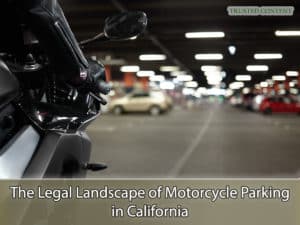How to Legally Park Your Motorcycle in California
Navigating the bustling streets and scenic routes of California on a motorcycle offers a sense of freedom and excitement. However, with the state's high concentration of motorcycle riders, understanding and adhering to motorcycle parking laws is crucial for every rider. This guide aims to shed light on the essential regulations governing motorcycle parking in California, ensuring that you park your motorcycle legally and safely.

The Legal Landscape of Motorcycle Parking in California
The Legal Landscape of Motorcycle Parking in California
California's approach to motorcycle parking laws is designed to ensure the safety of both motorcyclists and pedestrians. With specific statutes in place, these laws address various parking scenarios that riders may encounter. Adhering to these regulations not only helps in avoiding fines but also contributes to the orderly use of public spaces. As a rider in the Golden State, familiarizing yourself with these laws is a step towards responsible and lawful motorcycle operation.
Parking Garage Considerations for Motorcyclists
Understanding Garage Policies
Parking in a garage can sometimes be a challenge for motorcyclists. Not all parking garages are motorcycle-friendly, and some may have specific restrictions or designated areas for motorcycle parking. Before leaving your motorcycle in a parking garage, it's advisable to check with the garage management about their policies regarding motorcycle parking. This precaution can prevent potential issues, such as towing or fines, ensuring your motorcycle is parked safely and legally.
Benefits of Designated Motorcycle Parking
When available, designated motorcycle parking spaces in garages offer several advantages. These spaces are typically located in areas that provide added security and protection for motorcycles. Utilizing these designated spots can also reduce the risk of your motorcycle being accidentally hit by larger vehicles maneuvering in the garage. Always look for signage indicating motorcycle parking areas to make the most of these benefits.
Metered Parking Spaces and Motorcycles
Navigating Metered Parking
The rules for parking motorcycles in metered spaces can vary by city within California. In some areas, motorcycles are allowed to share metered spaces with other vehicles, while in others, they may be required to occupy a single space and pay the meter fee. It's essential to be aware of the local ordinances governing metered parking to avoid tickets and ensure that your parking practices are in line with local laws.
Sharing Metered Spaces
In jurisdictions that allow motorcycles to share metered spaces, riders should exercise caution and courtesy. Ensure that your motorcycle does not obstruct the access or exit of other vehicles in the space. Sharing spaces responsibly can help maintain good relations with fellow motorists and contribute to a positive parking environment for everyone.
Parking Between Cars
The Dos and Don'ts
While parking between cars can be convenient, especially in crowded areas, it's important to do so legally and considerately. The ability to park between cars without violating any laws depends on the specific city's regulations. Always ensure that there is ample space for both cars to maneuver without risking damage to your motorcycle or the vehicles. If in doubt, opt for a more traditional parking space to avoid potential conflicts or citations.
Legal Implications and Safety
Parking your motorcycle between cars without adhering to local laws can lead to fines and legal issues. Moreover, improperly parked motorcycles can be a safety hazard, posing risks to pedestrians and other motorists. By following the local guidelines and parking your motorcycle responsibly, you contribute to the safety and orderliness of the community.
Sidewalk Parking Restrictions
Understanding the Prohibition
In California, parking a motorcycle on the sidewalk is generally prohibited. This law aims to keep sidewalks clear for pedestrians, ensuring safe and unobstructed passage. The prohibition extends to any part of the vehicle, including accessories, from extending over the sidewalk. Violating this regulation can result in fines and the potential impounding of your motorcycle.
Exceptions and Considerations
While the general rule is clear, there may be exceptions based on local ordinances. Some areas might allow motorcycles to park on sidewalks in designated spots or under specific conditions. However, these exceptions are rare, and it's always best to look for alternative parking solutions to avoid inadvertently breaking the law.

Street Parking for Motorcycles in California
Street Parking for Motorcycles in California
Adhering to Vehicle Code 22502
When parking on the street, motorcycles are subject to California Vehicle Code 22502. This statute requires at least one wheel of the motorcycle to touch the curb. On one-way streets, this can be either curb, offering some flexibility to riders. Following this rule helps ensure that your motorcycle is parked securely and minimizes the risk of it being knocked over or impeding traffic flow.
Choosing Safe Locations
Beyond legal requirements, choosing a safe location for street parking is crucial. Look for well-lit areas and avoid parking in spots where your motorcycle could be a blind spot for other vehicles. Ensuring your motorcycle is visible and securely parked can prevent accidents and deter potential theft.

How to Legally Park Your Motorcycle in California
How to Legally Park Your Motorcycle in California
Understanding and complying with California's motorcycle parking laws is essential for every rider. By following these guidelines, you can enjoy the freedom of riding your motorcycle while ensuring the safety and legality of your parking practices. If you find yourself facing legal challenges related to motorcycle parking or any other issue, Napolin Accident Injury Lawyer is here to help. With extensive experience in representing injury victims and advising on motorcycle-related legal matters, we are committed to protecting your rights. For a free consultation, call us at (909) 962-8415. Let us support you in navigating the legal landscape, ensuring your peace of mind on and off the road.
